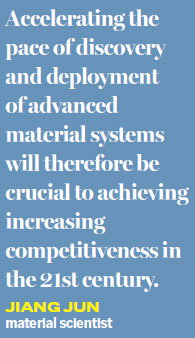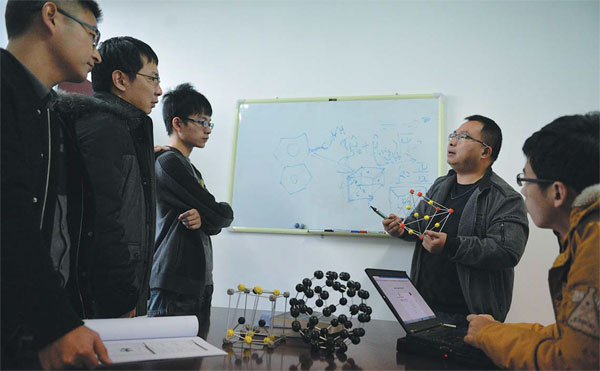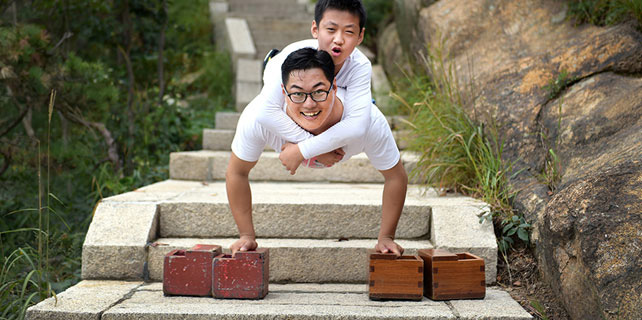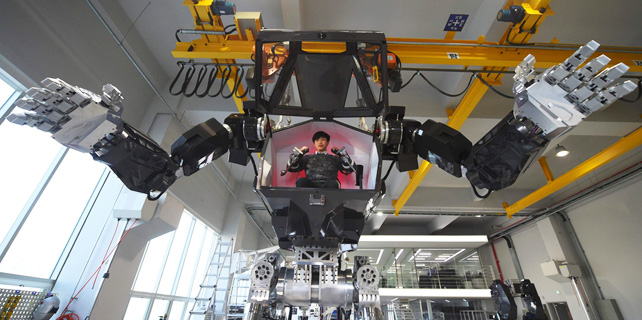Geek team breaks new ground in research
Gifted teenagers contribute to a genome database that will change the way new materials are discovered and used
A group of young scientists from the University of Science and Technology of China has built a database for the genomes of materials.
"As we know, it was after Thomas Edison had tried nearly 1,600 materials that he finally found the right one for the electric lamp," said Jiang Jun, a material scientist at the university, which is based in Hefei, the capital of East China's Anhui province.
Though more than 100 years have passed since Edison's work, the way scientists and enterprises develop new materials for certain purposes is often similar to how the great US inventor worked.
|
Jiang Jun (second right), a material scientist at USTC, discusses building a material genome database with his students. Xu Minhao / For China Daily |
"They have to try different materials before they can find the right one, and in modern times this can be quite a waste of time and money," said Jiang.
Advanced materials are essential to the economy and human well-being, yet it can take years after initial discovery to move a material to the market.
The professor, a PhD of the Swedish Royal Institute of Technology, has devoted himself to building a material genome database since he was recruited by USTC in 2011 through a national high-profile talent recruitment program.
Special class
Working at the USTC-based Hefei National Laboratory for Physical Sciences at the Microscale, Jiang also became head teacher of the university's special class for the gifted young, or the junior class, in 2012.
Established in 1978, the special class offers gifted youths the opportunity to skip a few years of middle and high school, so that the students in the class are years younger than normal university students. Some of the students are only 14.
The junior class initiative was the first of its kind in China and considered a major innovation in the nation's higher education system.
In a class for the young students, Jiang proposed the idea of forming a geek team to build the database system and three students immediately volunteered.
Although the students are in the same class, they are majoring in different scientific fields.

Huo Yaoying, one of the three students and a major in mathematics, then persuaded Li Rengzhi, another student who was considered a computer geek, to join the team.
Jiang cited an example of how these young students helped him when he was puzzled by a computing problem.
The students came to Jiang after they heard about his problem.
"This time, they taught me a one-hour class, which inspired me a lot and helped me to solve the problem sooner than I expected," said Jiang.
"The experience proved how brilliant and passionate the young students are and made me more confident about the plan to build the database system," said Jiang, whose team started work on the project in early 2014.
"Before we devoted ourselves to this project, my students were often too focused on experiments in the lab and seldom had ideas about how to apply their experimental findings to commercial practices," said Jiang.
Following the first members, more students have joined the team, which now includes seven students majoring in computer science, chemistry, physics and information technology.
"It is like piecing together a map with fragments and eventually we work out which direction we should move in," said Jiang, adding that six of the students come from the junior class.
Entrepreneurship
In 2011, the US launched the Materials Genome Initiative, which was designed to create a new era of policy, resources and infrastructure to support US institutions in the effort to discover, manufacture and deploy advanced materials twice as quickly and at a fraction of the cost.
The initiative exemplifies how important it is to build a materials database, Jiang said.
"Accelerating the pace of discovery and deployment of advanced material systems will therefore be crucial to achieving increasing competitiveness in the 21st century," he said.
In the last few years, Jiang's laboratory has collected characteristics data for nearly 10 million kinds of functional molecules, crystals and apparatuses.
Based on the data, Jiang's team has been working since early 2014 on a comprehensive information platform using computer technology and artificial intelligence.
After nearly two years of continuous trials and improvements, the team formally launched the Material Genome Big Data Platform in early 2016.
Jiang explained how the platform has helped a couple of companies to develop new products.
One of the companies wanted to develop a special memory metallic material and sought advice from Jiang's team on such factors as experiment scope, structure, temperature and pressure.
"As the team's first commercial practice, it helped the firm to save at least 42 million yuan ($6 million) of R&D costs and a lot of time," said Jiang.
Another firm had been trying to develop a kind of nanometer silver powder for more than five years but had not succeeded. With help from Jiang's team, the firm successfully developed the material in only two weeks.
The material genome platform won first prize in Anhui province's Internet Plus Innovation and Entrepreneurship Contest for College Students in August and then second prize in the national contest in November.
Although it proved practical and profitable through some completed cases, the team has not founded any companies because they thought they were not yet good enough at running a business.
Crucial support
In recent years, USTC has been encouraging its professors and young students to apply their academic findings to end-products and services.
"As one of the country's top universities, USTC is renowned for fundamental sciences, while it also aims to serve economic growth and people's lives with more scientific breakthroughs," said Zhao Lin, deputy chief of the university's youth league.
Zhao said there are also some other teams doing similar work to that of Jiang's team.
Earlier this year, the university's youth league and the association for young scholars jointly founded the Geek Center, which picked five from many applying teams as initial members.
"As the name explains, the member teams are all prominent academically. Their projects are mostly in the very early stages of commercial operation," said Zhao.
The center provides the member teams with financial support and guidance on how to improve their commercial operations.
Jiang's team is now planning to establish a company in the Institute of Advanced Technology, a research institute and also a high-tech park jointly founded in 2012 by the Anhui provincial government, the Chinese Academy of Sciences, the Hefei city government and USTC.
In contrast with the geek teems, the IAT is expected to power local economic growth with more end-products.
Zhulixin@chinadaily.com.cn
( China Daily European Weekly 12/30/2016 page30)



















